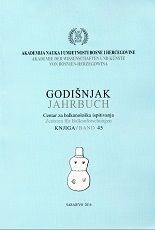Medieval Slag from Gornji Potočari (Srebrenica municipality, B&H): a relationship between initial Ore and metallurgical Processes
Medieval Slag from Gornji Potočari (Srebrenica municipality, B&H): a relationship between initial Ore and metallurgical Processes
Author(s): Almir Olovčić, Mustafa Memić, Almira Kevilj-Olovčić, Emina RamićSubject(s): Archaeology, Local History / Microhistory, Middle Ages
Published by: Akademija Nauka i Umjetnosti Bosne i Hercegovine
Keywords: lead slag; Middle Ages; AAS; Srebrenica; galena; sphalerite; silver;
Summary/Abstract: In this paper, chemical analysis of slag from abandoned medieval mine in Gornji Potočari, Srebrenica municipality was described. Total of 10 metals were analyzed: chromium, copper, cadmium, nickel, cobalt, zinc, silver, manganese, iron and lead. Traces of chromium, nickel, cobalt, copper, manganese and cadmium in the samples point to the fact that the starting ore also contained these elements. Results showed high content of iron (25.11–33.12%), lead (5.90–10.77%) and zinc (1.16–6.79%). The content of silver had a positive correlation with the content of lead, which is in favor of the initial hypothesis that the starting ore was galena (PbS). High zinc content indicates that the sphalerite (Zn,Fe)S was also used in the process, whereas iron most likely emanates from pyrite (FeS2 ). Galena and sphalerite can be found in Srebrenica area in large quantities. The results of the analysis show that the site was used for the production of lead and silver (from primary ores), intensive mining activity during the Middle Ages, and the latest date that we can account for slag origin is the end of the 16th century.
Journal: Godišnjak Centra za balkanološka ispitivanja
- Issue Year: 2017
- Issue No: 46
- Page Range: 215-224
- Page Count: 10
- Language: English

